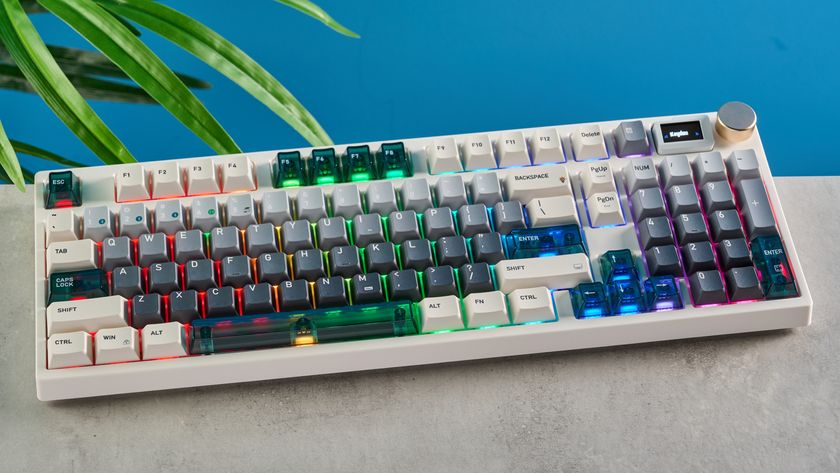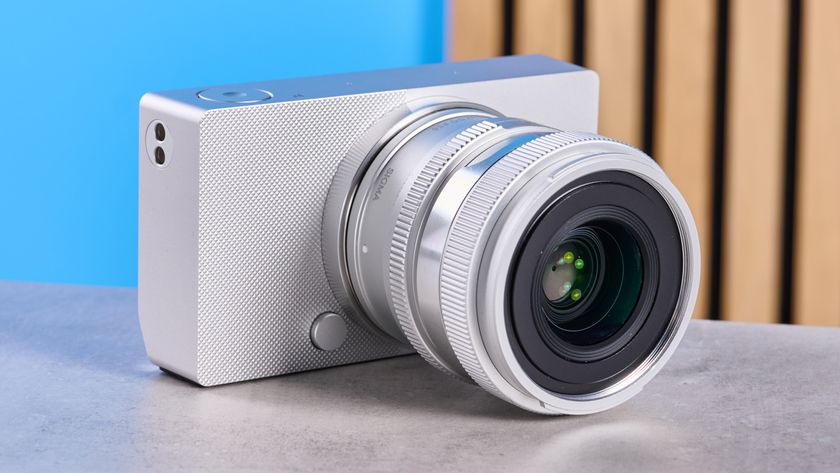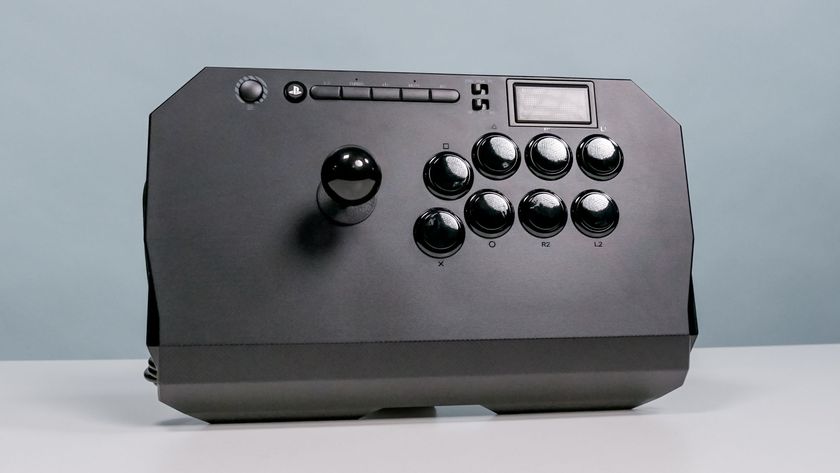Tom's Guide Verdict
LG's OLED TV comes close to perfection, thanks to gorgeous colors, stunning contrast and an intuitive smart-TV interface and remote.
Pros
- +
Stunning picture with unbeatable contrast
- +
OLED technology allows true black, unattainable on other sets
- +
Excellent smart features based on webOS interface and “magic” remote.
Cons
- -
The curved screen can be distracting
- -
Offers only HD, not ultra HD, resolution.
Why you can trust Tom's Guide
Who it's for: Discriminating viewers who want a state-of-the-art picture and don’t mind the curved screen, or the price.
Touted for years as the next great leap in TV technology, sets with organic light-emitting diode, aka OLED, panels have long looked promising in demonstrations. LG has delivered on that promise with its 55-inch 55EC9300, which offers a truly impressive HD 1080p picture that is destined to be the object of desire for videophiles.
OLED TVs achieve high contrast and deep blacks because each pixel in an OLED panel can be lit individually, without the backlight, and light leakage, of LCD screens. As a result, even the best 4K/UHD LCDs, such as the Samsung UN65HU8550F (see review) cannot match the brilliance and panache of the 55EC9300's HD picture. Going forward, LG plans to introduce only 4K OLED sets — at much higher prices than this HD model. LG’s 65-inch ultra HD OLED 65EC9700, for example, costs an eye-popping $12,000.
Design: Thrown a Curve
The hallmark of the 55EC9300 — and many LG TVs — is its curved screen. The idea, say manufacturers, is to create a more immediate, immersive cinemalike experience at home. However, I still find curved screens an annoyance unless I'm sitting smack dead center in front of it, where I can experience the wraparound immersive appeal.
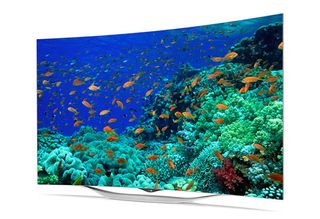
On the other hand, a curve is less likely to be distracting on an OLED screen, because an OLED’s picture does not deteriorate as severely with off-axis viewing compared with LCD sets (where brightness and colors wash out the farther to the side you sit).

Many buyers may find the curved display, the swoopy, wavelike silver stand and the razor-thin screen (0.17 inches at its narrowest point) aesthetically appealing. Others may not be able to shake the perceptible distortion at the edges of the screen, which looks preternaturally wide, while the center of the screen appears to be concave. This is definitely a set shoppers should see before buying.
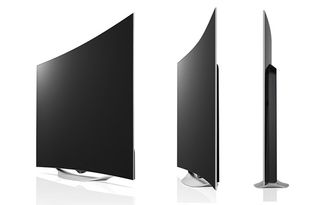
The back of the LG 55EC9300 has the usual RF component, and composite-video inputs, as well as four HDMI ports, three USB ports, optical audio out and an Ethernet port. There's built-in Wi-Fi support (802.11a/b/g/n/ac).
Interface: In the Palm of Your Hand
Making all the various features of connected smart TVs accessible and easy to navigate is no small feat, but LG does so with its webOS operating system in the 55EC9300. Snazzy on-screen icons are large enough to make their functions obvious from across a living room, with a pink flying teardrop cursor to highlight items and make selections. In general, the software was snappy and responsive, and I liked the way I could flip through the primary menu, with its angled tabs, along the bottom of the screen.
MORE: Best TVs You Can Buy Right Now
The main home screen is logically laid out, with the current input at the top left and a settings cog icon top right. On the left side, a home button invokes a quick settings list that includes network, sound and picture adjustments. A row of angled tabs appears along the bottom of the screen, with recently accessed inputs, sites and apps such as Netflix, Skype, Amazon and Vudu. LG has its own expanding app store to support the webOS interface, which the company says will be supported across its entire line.
Remote: Almost Magic
LG calls its smart remote control a Magic Remote. That may be a bit hyperbolic, but it is pretty darn good.

The egg-shaped compact remote acts like a wireless mouse that you wave in the air to direct an on-screen cursor. After a couple of turns, I found it completely comfortable, requiring less effort than trying to find menus and settings with a four-way toggle and multiple buttons on a conventional remote. The air mouse also works neatly with the webOS interface. For example, when you click on the settings icon, you get the options related specifically to your current input, rather than having to navigate through additional menus to get there.
Image Quality: Brilliant and Beautiful
LG's implementation of OLED technology is unique in that it uses the three traditional color elements — red, green and blue — in each pixel, plus a fourth white pixel. That design allows it to underscore some of the technology's strengths, and the principal of those is contrast ratio.
MORE: LG Defends OLED TVs' Future
When I watched a Blu-ray copy of Gravity, stars were unwavering points of light against the deep black of space. And where even ultra HD LCD sets can bleed light and create faint halos around bright objects on the screen, the LG OLED delivered clean, sharp lines without any blooming or blurring. Our contrast ratio measurements matched our subjective impressions with by far the highest number we've seen.
Colors were also quite accurate. There was no overemphasis of red to falsely warm up the picture, for example. Conversely, other shades did not suffer from a lack of saturation. Colors looked realistic, from the gunmetal gray of the Land Rover in the Blu-ray of Skyfall to the yellow taxicabs on Istanbul's streets, and blood looked blood red. Colorful market scenes also greatly benefited from the vibrant OLED reproduction.

I also found that the LG OLED set generated very little motion distortion or artifacts in fast chase scenes that had a lot of challenging background detail. Shards of flying glass from scenes in Skyfall looked crystal clear and sharp, even compared with an ultra HD picture on an LED-LCD TV such as the Samsung UN65HU8550F (see review).
Furthermore, the LG 55EC9300 handled a variety of program sources and resolutions with aplomb. A DVD of Skyfall, for example, looked remarkably good upscaled. There were no obvious artifacts, and even the moiré patterns you're likely to see in a herringbone suit or the jagged edges of angled lines — such as a door frame or windowsill — were kept to a minimum. The same could be said for 1080p HD streaming movies on Netflix, such as Catching Fire, and a football game recorded in 720p, which the TV ably upconverted to 1080p.
One additional aspect of this OLED TV was particularly noteworthy: screen uniformity. Most televisions have slight hotspots or flares in their pictures that generally indicate inconsistent backlighting. LG's 55EC9300 has no such weakness. Colors were solid across the screen, whether it was showing a clear blue sky or moonless night.
Audio Quality: Down to Earth
While the LG 55EC9300's picture may be exquisite, the sound is nothing exceptional. Playing movie soundtracks, it produced enough volume to draw complaints from neighbors. However, the sound feels cramped and focused under the center of the screen On the Skyfall soundtrack, Adele sounded like an American Idol contestant covering an Adele song, with much of her dynamic range squashed and the lower registers attenuated. Switching to the set's ultrasound mode and adjusting the built-in equalizer gave music a more open, wider feel, but ultimately couldn't eliminate the claustrophobic feeling. As usual, if you invest in a high-end TV, you should also invest in a soundbar or surround-sound system to get the full experience.
MORE: Best Soundbars
Burning Questions
Considering how relatively new OLED technology is in big displays, a nagging question remains about how susceptible OLED sets are to burn-in — the residual image left on a screen after a static picture has been displayed for too long. The materials used to create the individual subpixels have been considered more sensitive to such damage than those of LCDs. Indeed, manufacturers warn OLED owners not to display a static image (like your Netflix queue) for longer than an hour and to avoid old standard-definition 4:3 programs, because they are displayed with vertical black bars on the sides.
On the other hand, most LCD owners' manuals have similar warnings. We haven't had the opportunity to torture test an OLED set to see if we could intentionally burn in an image, and it may be the case that some sets become more sensitive to such effects as they age. Time will tell. But meanwhile, we recommend that you follow the manufacturer's guidelines to protect your large investment.
Bottom Line
Years spent squinting at screens and test results can jaundice any critical eye. But the LG 55EC9300 OLED set is a revelation. Its crystal-clear image and impressive contrast range will win over many viewers, even those who turn up their nose at the curved screen. The price is also right for this 55-inch set, considering that top-of-the-line LCDs cost as much and that slightly larger OLEDs are often three times the price. For now, the LG 55EC9300 sits in the sweet spot for buyers looking for the ultimate picture — until ultra HD OLEDs come down into the $3,000 range.
John R. Quain has been reviewing and testing video and audio equipment for more than 20 years. For Tom's Guide, he has reviewed televisions, HDTV antennas, electric bikes, electric cars, as well as other outdoor equipment. He is currently a contributor to The New York Times and the CBS News television program.
-
Stefan Peters amazon has best price atm www.amazon.com/LG-Electronics-55EC9300-55-Inch-Curved/dp/B00KZER5GS/?tag=techvor-20Reply -
jazzjamal Thank you for the detailed review. I just purchased this TV from microcenter for $1999! They had a coupon worth $1500 off their usual price -- $500 cheaper than amazon and costco!Reply










